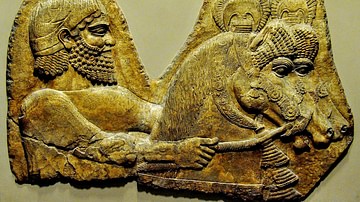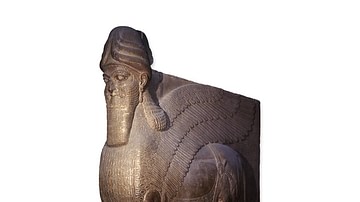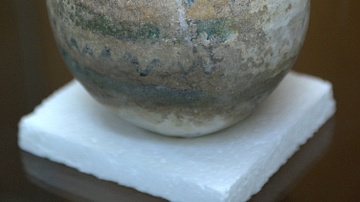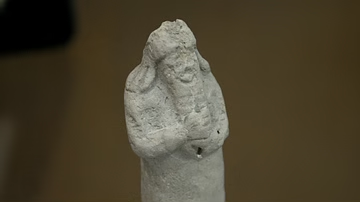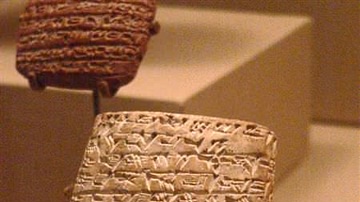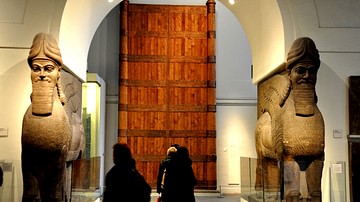Illustration
Statue of Ashurnasirpal II from Nimrud (ancient Kalhu), modern-day northern Iraq, Neo-Assyrian Empire, 883-859 BCE.
This statue of King Ashurnasirpal II (883-859 BCE) was placed in the Temple of Ishtar Sharrat-niphi. It was designed to remind the goddess Ishtar of the king's piety. It is made of magnesite and stands on a pedestal of a reddish stone. These unusual stones were probably brought back from a foreign campaign. Kings often boasted of the exotic things they acquired from abroad, not only raw materials and finished goods but also plants and animals.
The king's hair and beard are shown worn long in the fashion of the Assyrian court at this time. It has been suggested that the Assyrians used false hair and beards, as the Egyptians sometimes did, but there is no evidence for this.
Ashurnasirpal holds a sickle in his right hand, of a kind which gods are sometimes depicted using to fight monsters. The mace in his left hand shows his authority as vice-regent of the supreme god Ashur. The carved cuneiform inscription across his chest proclaims the king's titles and genealogy, and mentions his expedition westward to the Mediterranean Sea.
The statue was found in the nineteenth century by Henry Layard, the excavator of the temple.
References
- Grayson, A. Kirk & Novotny, Jamie. The Royal Inscriptions of Sennacherib, King of Assyria (704–681 BC), Part 1. Eisenbrauns, 2012.
- John E. Curtis & J.E. Reade. Art and Empire. Metropolitan Museum of Art, 1995.
- Layard, Sir Austen Henry. Discoveries Among the Ruins of Nineveh and Babylon. Forgotten Books, 2012.
- Reade, Julian. Assyrian Sculpture. British Museum, 2012.
Cite This Work
APA Style
Museum, T. o. t. B. (2012, April 26). Statue of Ashurnasirpal II. World History Encyclopedia. Retrieved from https://www.worldhistory.org/image/528/statue-of-ashurnasirpal-ii/
Chicago Style
Museum, Trustees of the British. "Statue of Ashurnasirpal II." World History Encyclopedia. Last modified April 26, 2012. https://www.worldhistory.org/image/528/statue-of-ashurnasirpal-ii/.
MLA Style
Museum, Trustees of the British. "Statue of Ashurnasirpal II." World History Encyclopedia. World History Encyclopedia, 26 Apr 2012, https://www.worldhistory.org/image/528/statue-of-ashurnasirpal-ii/. Web. 06 May 2025.

